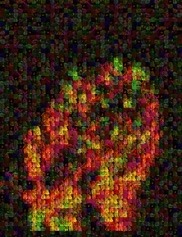Dearborn R, Kunes S.
An axon scaffold induced by retinal axons directs glia to destinations in the Drosophila optic lobe. Development. 2004;131 (10) :2291-303.
AbstractIn the developing Drosophila visual system, glia migrate into stereotyped positions within the photoreceptor axon target fields and provide positional information for photoreceptor axon guidance. Glial migration conversely depends on photoreceptor axons, as glia precursors stall in their progenitor zones when retinal innervation is eliminated. Our results support the view that this requirement for retinal innervation reflects a role of photoreceptor axons in the establishment of an axonal scaffold that guides glial cell migration. Optic lobe cortical axons extend from dorsal and ventral positions towards incoming photoreceptor axons and establish at least four separate pathways that direct glia to proper destinations in the optic lobe neuropiles. Photoreceptor axons induce the outgrowth of these scaffold axons. Most glia do not migrate when the scaffold axons are missing. Moreover, glia follow the aberrant pathways of scaffold axons that project aberrantly, as occurs in the mutant dachsous. The local absence of glia is accompanied by extensive apoptosis of optic lobe cortical neurons. These observations reveal a mechanism for coordinating photoreceptor axon arrival in the brain with the distribution of glia to multiple target destinations, where they are required for axon guidance and neuronal survival.
Yang H, Kunes S.
Nonvesicular release of acetylcholine is required for axon targeting in the Drosophila visual system. Proc Natl Acad Sci U S A. 2004;101 (42) :15213-8.
AbstractWe report evidence for a developmental role of acetylcholine in axon pathfinding in the Drosophila visual system. Acetylcholine was detected on photoreceptor axons during their navigation to target sites in the brain, a time well before the formation of functional synapses. The pattern of photoreceptor axon projections was severely disrupted when acetylcholine synthesis or metabolism was altered or eliminated, or when transgenic alpha-bungarotoxin, a nicotinic acetylcholine receptor antagonist, was expressed in the developing eye or brain. The requirement for acetylcholine signaling exists before photoreceptor neurons form synaptic connections and does not require the function of vesicular acetylcholine transporter protein. That this early effect of acetylcholine is mediated through nonvesicular release is further supported by the observation that transgenic expression of tetanus toxin, a blocker of neurotransmitter release via synaptic vesicles, did not cause similar photoreceptor axon projection defects. These observations support the notion that a form of acetylcholine secretion mediates the behavior of growth cones during axon pathfinding.
Dearborn R, Kunes S.
An axon scaffold induced by retinal axons directs glia to destinations in the Drosophila optic lobe. Development (Cambridge, England). 2004;131 (10) :2291-303.
AbstractIn the developing Drosophila visual system, glia migrate into stereotyped positions within the photoreceptor axon target fields and provide positional information for photoreceptor axon guidance. Glial migration conversely depends on photoreceptor axons, as glia precursors stall in their progenitor zones when retinal innervation is eliminated. Our results support the view that this requirement for retinal innervation reflects a role of photoreceptor axons in the establishment of an axonal scaffold that guides glial cell migration. Optic lobe cortical axons extend from dorsal and ventral positions towards incoming photoreceptor axons and establish at least four separate pathways that direct glia to proper destinations in the optic lobe neuropiles. Photoreceptor axons induce the outgrowth of these scaffold axons. Most glia do not migrate when the scaffold axons are missing. Moreover, glia follow the aberrant pathways of scaffold axons that project aberrantly, as occurs in the mutant dachsous. The local absence of glia is accompanied by extensive apoptosis of optic lobe cortical neurons. These observations reveal a mechanism for coordinating photoreceptor axon arrival in the brain with the distribution of glia to multiple target destinations, where they are required for axon guidance and neuronal survival.
Yang H, Kunes S.
Nonvesicular release of acetylcholine is required for axon targeting in the Drosophila visual system. Proceedings of the National Academy of Sciences of the United States of America. 2004;101 (42) :15213-8.
AbstractWe report evidence for a developmental role of acetylcholine in axon pathfinding in the Drosophila visual system. Acetylcholine was detected on photoreceptor axons during their navigation to target sites in the brain, a time well before the formation of functional synapses. The pattern of photoreceptor axon projections was severely disrupted when acetylcholine synthesis or metabolism was altered or eliminated, or when transgenic alpha-bungarotoxin, a nicotinic acetylcholine receptor antagonist, was expressed in the developing eye or brain. The requirement for acetylcholine signaling exists before photoreceptor neurons form synaptic connections and does not require the function of vesicular acetylcholine transporter protein. That this early effect of acetylcholine is mediated through nonvesicular release is further supported by the observation that transgenic expression of tetanus toxin, a blocker of neurotransmitter release via synaptic vesicles, did not cause similar photoreceptor axon projection defects. These observations support the notion that a form of acetylcholine secretion mediates the behavior of growth cones during axon pathfinding.

